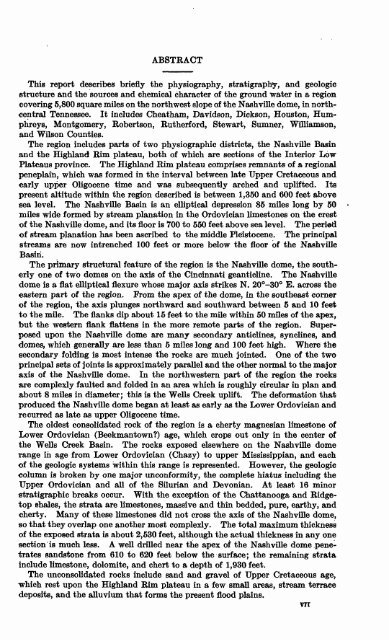GROUND WATER IN NORTH-CENTRAL TENNESSEE
GROUND WATER IN NORTH-CENTRAL TENNESSEE
GROUND WATER IN NORTH-CENTRAL TENNESSEE
You also want an ePaper? Increase the reach of your titles
YUMPU automatically turns print PDFs into web optimized ePapers that Google loves.
ABSTRACT<br />
This report describes briefly the physiography, stratigraphy, and geologic<br />
structure and the sources and chemical character of the ground water in a region<br />
covering 5,800 square miles on the northwest slope of the Nashville dome, in north-<br />
central Tennessee. It includes Cheatham, Davidson, Dickson, Houston, Hum<br />
phreys, Montgomery, Roberfcson, Rutherford, Stewart, Sumner, Williamson,<br />
and Wilson Counties.<br />
The region includes parts of two physiographic districts, the Nashville Basin<br />
and the Highland Rim plateau, both of which are sections of the Interior Low<br />
Plateaus province. The Highland Rim plateau comprises remnants of a regional<br />
peneplain, which was formed in the interval between late Upper Cretaceous and<br />
early upper Oligocene time and was subsequently arched and uplifted. Its<br />
present altitude within the region described is between 1,350 and 600 feet above<br />
sea level. The Nashville Basin is an elliptical depression 85 miles long by 50<br />
miles wide formed by stream planation in the Ordovician limestones on the crest<br />
of the Nashville dome, and its floor is 700 to 550 feet above sea level. The period<br />
of stream planation has been ascribed to the middle Pleistocene. The principal<br />
streams are now intrenched 100 feet or more below the floor of the Nashville<br />
Basin.<br />
The primary structural feature of the region is the Nashville dome, the south<br />
erly one of two domes on the axis of the Cincinnati geanticline. The Nashville<br />
dome is a flat elliptical flexure whose major axis strikes N. 20°-30° E. across the<br />
eastern part of the region. From the apex of the dome, in the southeast corner<br />
of the region, the axis plunges northward and southward between 5 and 10 feet<br />
to the mile. The flanks dip about 15 feet to the mile within 50 miles of the apex,<br />
but the western flank flattens in the more remote parts of the region. Super<br />
posed upon the Nashville dome are many secondary anticlines, synclines, and<br />
domes, which generally are less than 5 miles long and 100 feet high. Where the<br />
secondary folding is most intense the rocks are much jointed. One of the two<br />
principal sets of joints is approximately parallel and the other normal to the major<br />
axis of the Nashville dome. In the northwestern part of the region the rocks<br />
are complexly faulted and folded in an area which is roughly circular in plan and<br />
about 8 miles in diameter; this is the Wells Creek uplift. The deformation that<br />
produced the Nashville dome began at least as early as the Lower Ordovician and<br />
recurred as late as upper Oligocene time.<br />
The oldest consolidated rock of the region is a cherty magnesian limestone of<br />
Lower Ordovician (Beekmantown?) age, which crops out only in the center of<br />
the Wells Creek Basin. The rocks exposed elsewhere on the Nashville dome<br />
range in age from Lower Ordovician (Chazy) to upper Mississippian, and each<br />
of the geologic systems within this range is represented. However, the geologic<br />
column is broken by one major unconformity, the complete hiatus including the<br />
Upper Ordovician and all of the Silurian and Devonian. At least 16 minor<br />
stratigraphic breaks occur. With the exception of the Chattanooga and Ridge-<br />
top shales, the strata are limestones, massive and thin bedded, pure, earthy, and<br />
cherty. Many of these limestones did not cross the axis of the Nashville dome,<br />
so that they overlap one another most complexly. The total maximum thickness<br />
of the exposed strata is about 2,530 feet, although the actual thickness in any one<br />
section is much less. A well drilled near the apex of the Nashville dome pene<br />
trates sandstone from 610 to 620 feet below the surface; the remaining strata<br />
include limestone, dolomite, and chert to a depth of 1,930 feet.<br />
The unconsolidated rocks include sand and gravel of Upper Cretaceous age,<br />
which rest upon the Highland Rim plateau in a few small areas, stream terrace<br />
deposits, and the alluvium that forms the present flood plains.<br />
vn

















